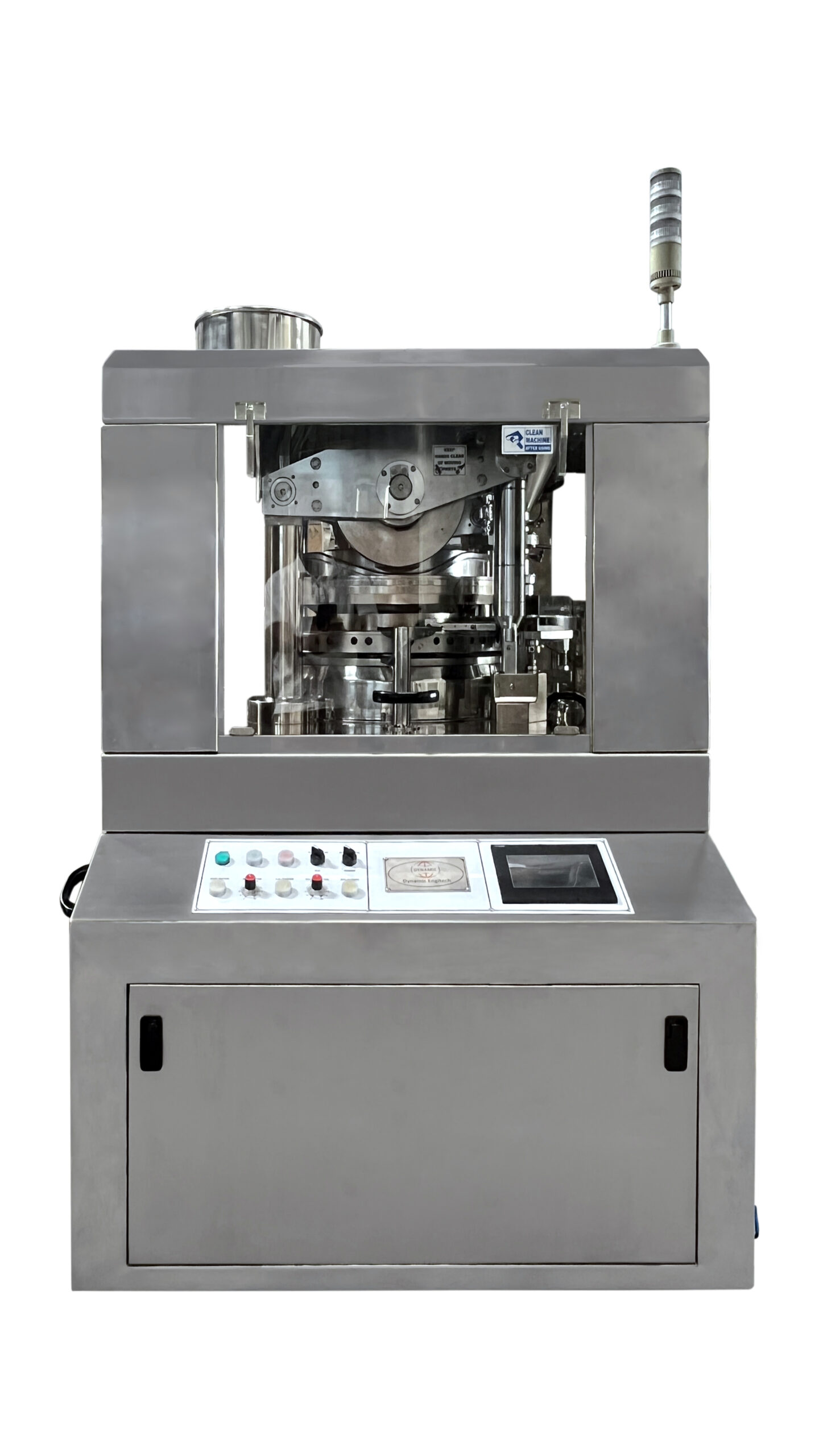
Double Rotary Tablet Press / Compression Machine: 27D/ 27B/ 35B/ 45BB Stations
Features of Double Rotary Tablet Press – 27D or 27B, 35B, 45BB Tooling Stations :
Square GMP model double rotary tablet press. Operator-friendly design, provided with electronic digital tablet cum RPM counter. Reverse-direction motion protection is also provided for safety purposes.
Provided with double-sided lifting cams. An extra hand wheel is provided for easy loading of punch die sets.
- CI body and turret of special grade iron casting with CI middle plate, imported needle roller, and bearing provided at the bottom of the turret. Also available with a middle plate of turret made of 316-grade stainless steel.
- There are not any painted parts in the tablet manufacturing zone as all parts are made of stainless steel 304 or gunmetal or of hard chrome plated. All hardware used in the machine has a stainless steel 304 quality in the tablet manufacturing zone.
- It is provided with disk type friction clutch start system.
- Upper punch penetration system, variable speed pulley, one shot lubrication system & anti vibrating mount.
- Lower guard of polished stainless steel and upper guards of acrylic material. Turret guards have a sturdy aluminum frame. All guards are interlocked for safety.

- Effective dust extraction nozzles.
Customization Options Available
- Force Feeding Attachment
- Two Layer / Bilayer Tablet Attachment
- Poly Carbonate Upper Guards
- Auto Lubrication Pump
- A machine with outside control is available (See the Picture)
Why Choose Our Double Rotary Tablet Press Machine?
Our Double Rotary Tablet Press machine is manufactured with the best quality materials that are cost-effective. This machine can continuously produce tablets. Here are some quality and efficiency monitoring aspects of the Double Rotary Tablet Press Machine:
- Durability
- Proper & precise assembling
- Low maintenance
- Finishing
- Power efficiency
- Effective for heavy-duty work
- Noise control
Features of our Double Rotary Tablet Press machine
- Easy and more thorough cleaning
- Digital tablet cum RPM counter
- PLC Control System
- Auto Lubrication System
- Aluminum turret guards
Safety Features
- Emergency Stop Button
- Interlocking Safety Guards
- The quality mechanism that releases overload pressure
- Overload Protection
- Reverse direction mode
- Turret Anti-Turning Mechanism
- There is not any painted parts in tablet manufacturing zone as all parts are made of stainless steel 304 or gunmetal or of hard chrome plated. All hardware used in the machine has stainless steel 304 quality in tablet manufacturing zone.
- It is provided with disk type friction clutch start system.
- Upper punch penetration system, variable speed pulley, one shot lubrication system & anti vibrating mount.
- Lower guard of polished stainless steel and upper guards of acrylic material. Turret guards have sturdy aluminum frame. All guards are interlocked for safety.

- Effective dust extraction nozzles.
- Options are available for customization like (1) Force Feeding Attachment (2) Two Layer / Bilayer Tablet Attachment (3) Poly Carbonate Upper Guards (4) Auto Lubrication Pump (5) Machine with out side control is available (See the Picture)
Technical Specifications of Double Rotary Tablet Press/Compression Machine – 27D / 27B / 35B / 45BB Stations:
| Model | TPC – 27 – D | TPC – 27 – B | TPC – 35 -B | TPC – 45 -BB |
| Type of Tooling | “D” | “B” | “B” | “BB” |
| No. of Stations | 27 | 27 | 35 | 45 |
| Tablets Output /hour* (Max.) | 129600 | 129600 | 168000 | 216000 |
| Operating Pressure Max. (Ton) | 10 | 6.5 | 6.5 | 6.5 |
| Tablet Diameter Max. (mm) | 25 | 16 | 16 | 11.5 |
| Depth of Fill Max. (mm) | 20.5 | 17.5 | 17.5 | 17.5 |
| Upper Punch Penetration (mm) | 1.5 – 8 | 1.5 – 8 | 1.5 – 8 | 1.5 – 8 |
| Total Ele. Power (hp) | 5 HP | |||
| Electric Power Supply | 3 Phase, 1440 RPM, 415 V., 50 Hz. OR As Per the requirement of Customer | |||
| Turret RPM Max. | 40 | |||
| Tablet Press Dimension (mm) (Approx.) | 1000 x 1040 x 1790 | |||
| Net Weight (kgs) (Approx.)) | 1143 | |||
* Depending upon the tooling size, shape and material characteristics
Note: We reserve right to change specifications without any prior notice.
FOR PHARMACEUTICAL & NUTRACEUTICAL PRODUCTS








FOR CONFECTIONERY & HARD CANDY & FOOD PRODUCTS



Tableting Equipments/Allied Machines


